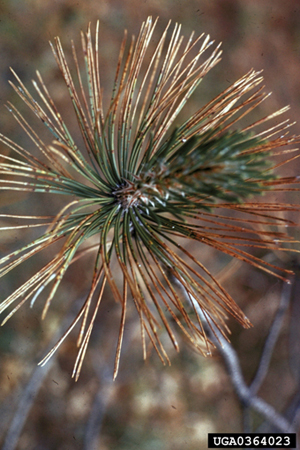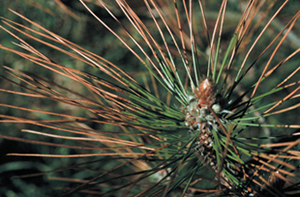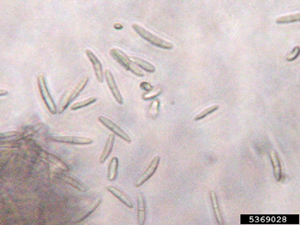G2070
Dothistroma Needle Blight of Pine
Dothistroma needle blight affects established pine trees, especially the Austrian and ponderosa pines in Nebraska. Following the cultural practices described here can reduce the disease’s impact.
Amy D. Timmerman, Extension Educator, Plant Pathology
The browning and death of older needles is often due to Dothistroma needle blight, a disease caused by the fungus, Dothistroma pini. Infection typically starts on the lower branches and gradually moves up the tree. Under severe disease pressure, it may kill the entire tree.
Dothistroma pini is common in well-established pine plantings and seldom infects young seedlings. It can, however, be commonly observed in older transplants in nurseries. Needle blight occurs in landscapes, shelterbelts, Christmas tree farms, and natural forests. There are over 29 species of pine that can be infected. In Nebraska, the disease is most severe on Austrian pine (Pinus nigra) and ponderosa pine (P. ponderosa), but it can also damage lodgepole pine (P. contorta).
Symptoms
Initial symptoms appear as yellow to tan colored spots on the needle. The yellow to tan spots enlarge to become brown or reddish brown bands (Figure 1), which encircle the entire needle. These bands will eventually girdle the needle, causing the remainder to die. Death of the needle occurs only from the point of infection to the tip, while the base of the needle remains green (Figure 2). Black fruiting bodies (stromata) of the fungus are produced in the bands (Figure 3) or in dead areas of the needle in the fall.
Disease Cycle
The stromata form under the epidermis of the needle and break through the epidermis in the fall. These stromata contain conidia (spores) (Figure 4), which do not mature until the following spring. The conidia are released in the spring during cool, wet weather and are dispersed by rain splash or wind. The dispersed spores infect second year or older needles. Symptoms are not visible on newly infected needles until early fall.
 |
 |
|
| Figure 1. Dark brown bands evident on infected needles. (Photo courtesy of Robert L. Anderson, USDA Forest Service, bugwood.org.) | Figure 2. The base of infected needles remains green. (Photo courtesy of Loren Giesler, University of Nebraska–Lincoln.) | |
 |
 |
|
| Figure 3. Stromata breaking the epidermis of an infected needle at 25x magnification. | Figure 4. Conidia of Dothistroma pini. (Photo courtesy of Paul Bachi, University of Kentucky Research and Education Center, bugwood.org.) |
Management
The use of cultural practices can reduce the severity of Dothistroma needle blight. Since the development of this fungal disease is favored by wet conditions, trees should be adequately spaced to provide air movement. Planting new trees in low-lying areas with poor drainage should be avoided. Sanitation around infected trees and pruning infected branches can reduce inoculum levels, which are responsible for new infections.
Fungicides can effectively prevent infection when the first application is made in mid-May to protect the previous year’s needles, and a second application is made three to four weeks later. Read and follow all label directions carefully before making any application (Table I).
| Table I. Fungicides available for Dothistroma tip blight control. | |||
| Fungicide Active Ingredient | Trade Name | Aerial
Application |
Commercial (C)/
Homeowner (H) Use |
| Copper | Bordeaux
Mixture (ACME) |
No |
H |
| Copper Hydroxide | Kocide® 2000
(DuPont™) |
No |
C |
| Copper Salt | Camelot
(Griffin) |
No |
C |
| Mancozeb | Junction (SePro) |
Yes |
C |
This publication has been peer reviewed.
Disclaimer Reference to commercial products or trade names is made with the understanding that no discrimination is intended of those not mentioned and no endorsement by University of Nebraska–Lincoln Extension is implied for those mentioned. |
Visit the University of Nebraska–Lincoln Extension Publications Web site for more publications.
Index: Plant Diseases
Trees
Issued May 2011